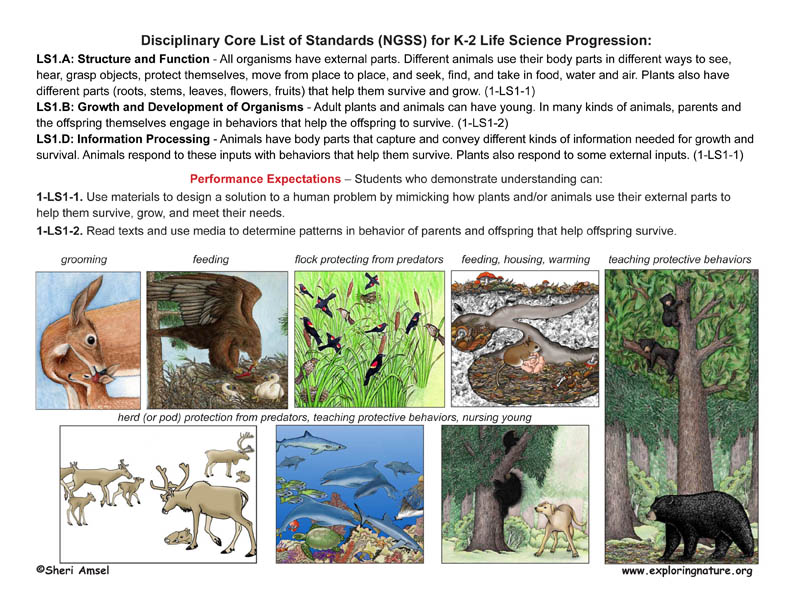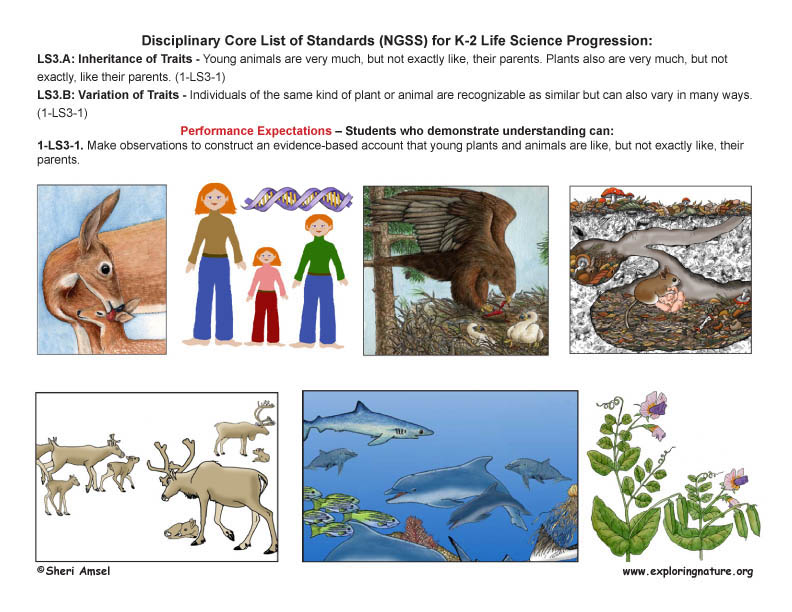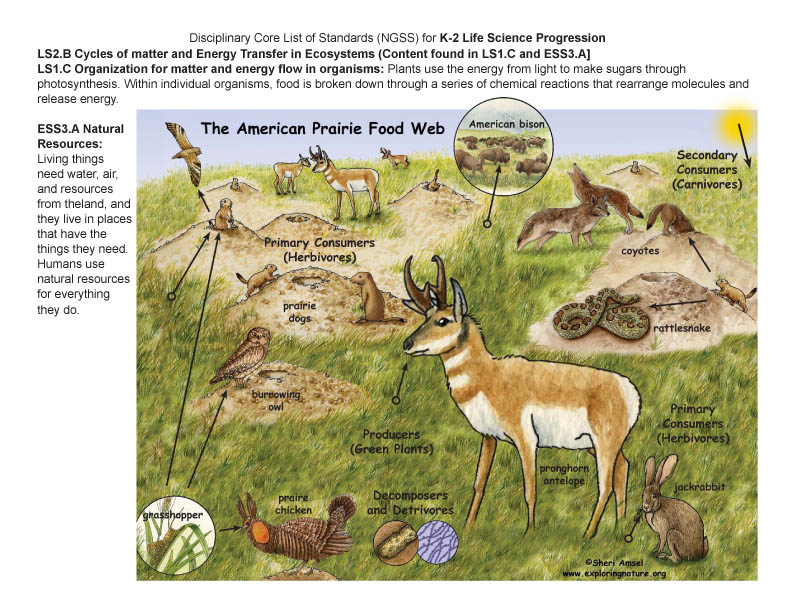

A Disciplinary Core List of Standards (NGSS) by Grade
K-2 Life Science Progression:
LS1.A Structure and Function
All organisms have external parts that they use to perform daily functions. (Different animals use their body parts in different ways to see, hear, grasp objects, protect themselves, move from place to place, and seek, find, and take in food, water and air. Plants also have different parts (roots, stems, leaves, flowers, fruits) that help them survive and grow.)
LS1.B Growth and Development of Organisms
Parents and offspring often engage in behaviors that help the offspring survive.
LS1.C Organization for Matter and Energy Flow in Organism
Animals obtain food they need from plants or other animals. Plants need water and light. (All animals need food in order to live and grow. They obtain their food from plants or from other animals. Plants need water and light to live and grow. )
LS1.D Information Processing
Animals sense and communicate information and respond to inputs with behaviors that help them grow and survive. (Plants also respond to some external inputs.)
LS2.A Interdependent Relationships in Ecosystems
Plants depend on water and light to grow, and also depend on animals for pollination or to move their seeds around.
LS2.B Cycles of matter and Energy Transfer in Ecosystems (Content found in LS1.C and ESS3.A]
LS2.C Ecosystem Dynamics, Functioning, and resilience - N/A
LS2.D Social Interactions and Group Behavior - N/A
LS3.A Inheritance of Traits
Young organisms are very much, but not exactly, like their parents and also resemble other organisms of the same kind.
LS3.B Variation of Traits
Individuals of the same kind of plant or animal are recognizable as similar but can also vary in many ways. (1-LS3-1)
LS4.A Evidence of Common Ancestry and Diversity - N/A
LS4.B Natural Selection - N/A
LS4.C Adaptation - N/A
LS4.D Biodiversity and Humans
A range of different organisms lives in different places. (There are many different kinds of living things in any area, and they exist in different places on land and in water. )
____________________________________________________________________________________________
NGSS Performance Expectations
Students who demonstrate understanding can:
1-LS1-1. Use materials to design a solution to a human problem by mimicking how plants and/or animals use their external parts to help them survive, grow, and meet their needs.* [Clarification Statement: Examples of human problems that can be solved by mimicking plant or animal solutions could include designing clothing or equipment to protect bicyclists by mimicking turtle shells, acorn shells, and animal scales; stabilizing structures by mimicking animal tails and roots on plants; keeping out intruders by mimicking thorns on branches and animal quills; and, detecting intruders by mimicking eyes and ears.]
1-LS1-2. Read texts and use media to determine patterns in behavior of parents and offspring that help offspring survive. [Clarification Statement: Examples of patterns of behaviors could include the signals that offspring make (such as crying, cheeping, and other vocalizations) and the responses of the parents (such as feeding, comforting, and protecting the offspring).]
K-LS1-1. Use observations to describe patterns of what plants and animals (including humans) need to survive. [Clarification Statement: Examples of patterns could include that animals need to take in food but plants do not; the different kinds of food needed by different types of animals; the requirement of plants to have light; and, that all living things need water.]
2-LS2-1. Plan and conduct an investigation to determine if plants need sunlight and water to grow. [Assessment Boundary: Assessment is limited to testing one variable at a time.]
2-LS2-2. Develop a simple model that mimics the function of an animal in dispersing seeds or pollinating plants.*
1-LS3-1. Make observations to construct an evidence-based account that young plants and animals are like, but not exactly like, their parents. [Clarification Statement: Examples of patterns could include features plants or animals share. Examples of observations could include leaves from the same kind of plant are the same shape but can differ in size; and, a particular breed of dog looks like its parents but is not exactly the same.] [Assessment Boundary: Assessment does not include inheritance or animals that undergo metamorphosis or hybrids.]
2-LS4-1. Make observations of plants and animals to compare the diversity of life in different habitats. [Clarification Statement: Emphasis is on the diversity of living things in each of a variety of different habitats.] [Assessment Boundary: Assessment does not include specific animal and plant names in specific habitats.]
Content Links for Life Science
____________________________________________________________________________________________
NGSS Illustrated Posters
Specific Standards Unpacked and Illustrated for Clarity
Print them out for display in classroom.
(Poster PDF is large so will take a few momemts to load.)
When you research information you must cite the reference. Citing for websites is different from citing from books, magazines and periodicals. The style of citing shown here is from the MLA Style Citations (Modern Language Association).
When citing a WEBSITE the general format is as follows.
Author Last Name, First Name(s). "Title: Subtitle of Part of Web Page, if appropriate." Title: Subtitle: Section of Page if appropriate. Sponsoring/Publishing Agency, If Given. Additional significant descriptive information. Date of Electronic Publication or other Date, such as Last Updated. Day Month Year of access < URL >.
Amsel, Sheri. "Grade K-2 Life Science Standards and Posters (8.5 x11")" Exploring Nature Educational Resource ©2005-2024. December 15, 2024
< http://exploringnature.org/db/view/Grade-K-2-Life-Science-Standards-and-Posters-85-x11quot >






